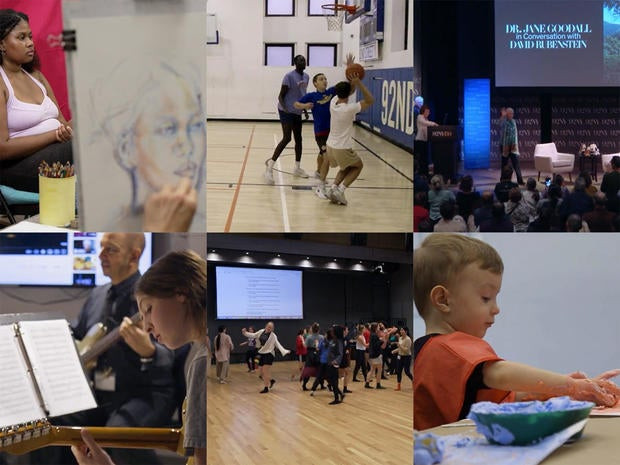For a century and a half, the 92nd Street Y in NYC has stood as a vibrant hub in Manhattan, offering a diverse range of programs and embodying the spirit of community. More than just a community center, 92NY, as it is also known, boasts a rich history intertwined with notable figures and groundbreaking events, shaping its identity as a unique cultural institution. From its humble beginnings as a safe haven for Jewish immigrants to becoming a world-renowned stage for arts, talks, and personal growth, the 92nd Street Y’s journey reflects the evolving tapestry of New York City itself.
Founded in 1874, the 92nd Street Y initially emerged as the Young Men’s Hebrew Association (YMHA). Its inception was driven by a group of German Jewish civic leaders who recognized the needs of the influx of Eastern European Jewish immigrants arriving in the United States. Seeking to create a welcoming space, they envisioned “a Jewish version of the YMCA,” as current CEO Seth Pinsky explains. This vision quickly materialized, providing a crucial “home, a safe place” for newcomers navigating a new world. The organization’s commitment to inclusivity and community building was embedded in its DNA from the very start. In 1930, the 92nd Street Y found its permanent home at its current location on Lexington Avenue and 92nd Street, solidifying its presence in the heart of Manhattan.
 Diverse activities at the 92nd Street Y, NYC, including arts, sports, and talks.
Diverse activities at the 92nd Street Y, NYC, including arts, sports, and talks.
The welcoming spirit of 92NY is perhaps best exemplified by the historic Kaufmann Concert Hall. This iconic venue has been a platform for groundbreaking moments in arts and literature. Truman Capote first shared excerpts from “In Cold Blood” within its walls, and Kurt Vonnegut introduced “Breakfast of Champions” to the world from its stage. Even Emma Lazarus, whose words on the Statue of Liberty (“Give me your tired, your poor, your huddled masses yearning to breathe free”) resonate globally, taught English to Jewish immigrants at the 92nd Street Y, further cementing its role as a beacon of hope and opportunity.
The Kaufmann Concert Hall’s stage has resonated with the voices of a remarkably diverse array of influential figures. From Holocaust survivor Elie Wiesel sharing his poignant experiences to music icon Rod Stewart captivating audiences, the hall has hosted luminaries from every field. Supreme Court Justice Ruth Bader Ginsburg, science communicators Bill Nye and Neil deGrasse Tyson, and political powerhouses Hillary and Bill Clinton are just a few examples of the diverse personalities who have graced the 92NY stage. The institution has also welcomed countless stars of film, television, theater, and comedy, solidifying its reputation as a premier cultural venue in New York City.
The 92nd Street Y’s commitment to artistic innovation is further highlighted by its historical embrace of dance. In 1960, choreographer Alvin Ailey chose the 92NY stage to premiere “Revelations,” now recognized as one of his most celebrated works. This pivotal moment underscores the organization’s long-standing dedication to providing a platform for artists who might have been excluded elsewhere. CEO Seth Pinsky poignantly explains this ethos by stating, “Jews have a long history of being excluded, and as a result of that, it’s a very important value for us not to exclude others for the same reason.” This principle of inclusion remains a core value guiding the 92nd Street Y’s programming and community engagement.
Despite navigating contemporary challenges, including recent controversies surrounding event cancellations, the 92nd Street Y remains steadfastly guided by its founding values, particularly “tikkun olam.” This Hebrew phrase, meaning “to repair the world,” encapsulates the organization’s ongoing mission to enrich lives and foster a strong sense of community. The diverse programming at 92nd Street Y Nyc reflects this commitment, offering everything from ceramics and parenting classes to in-depth explorations of art history. Furthermore, its renowned nursery school and the distinguished 92NY Talks series exemplify the breadth and depth of its offerings, catering to a wide spectrum of interests and age groups.
 Diverse activities at the 92nd Street Y, NYC, including arts, sports, and talks.
Diverse activities at the 92nd Street Y, NYC, including arts, sports, and talks.
Personal stories further illuminate the profound impact of the 92nd Street Y on individuals’ lives. Lincoln Field, 82, has honed his musical talents through decades of guitar lessons with Ed MacEachen at 92NY. Joanne Krantz finds creative expression at the Jewelry Center, while Peter Stokes, a fixture in the basketball court for nearly 50 years, emphasizes the enduring camaraderie and health benefits he’s gained. For Peter, it’s “a great meeting place to meet people,” forging “lifelong friends” through shared activities.
Looking back at 150 years of history, the founders of the 92nd Street Y NYC may not have envisioned the full scope of its evolution. However, CEO Seth Pinsky affirms that their core vision remains vibrantly alive. It continues to be “a place for people to make their lives more meaningful,” a space “for people to connect to other people and not feel alone and isolated.” As the 92nd Street Y embarks on its next 150 years, this enduring mission of community enrichment and cultural engagement is poised to remain unchanged, continuing its legacy as a vital New York City institution.
For more information:
- 92nd Street Y Official Website, New York City
Based on a story by CBS News.
